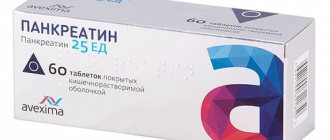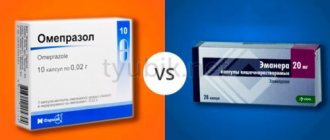Diseases of the stomach and gastrointestinal tract are accompanied by an increase in the secretion of gastric juice with an increased concentration of hydrochloric acid in it. With the help of the drug Renitidine, you can reduce the secretion of juice, and the drug is also used to treat many diseases of the gastrointestinal tract. Next, we will consider the composition of Ranitidine, as well as indications for use.
Help with stomach diseases
Ranitidine: release form - tablets
Ranitidine is a drug used to treat stomach ulcers and chronic gastritis; it belongs to the group of histamine receptor blockers. The acidic environment of the stomach negatively affects the mucous membrane and destroys its walls.
If the mucous membrane is affected by ulcers, the acidic environment can cause gastric bleeding. Bleeding occurs due to the destruction of the walls of blood vessels in the tissues of the stomach. The action of an acidic environment on an ulcer can cause a perforated ulcer, which results in peritonitis and inflammatory processes in the abdominal cavity.
The stomach walls sometimes break down after taking medications that contain acid, such as Aspirin. Stress often negatively affects the health of the entire body, including the stomach, causing heartburn. While taking the drug, there is a gradual decrease in the concentration of gastric juice and a decrease in hydrochloric acid in its composition.
The amount of gastric juice produced gradually decreases. This allows you to get rid of the unpleasant burning sensation in the stomach and reduce pain. By acting on receptors, the drug stimulates the renewal of the mucous membrane and triggers the protective properties of cells by enhancing their microcirculation.
The drug is available in film-coated tablets and in the form of a solution.
Tablets can be prescribed without a doctor's prescription. The solution is used in hospitals to treat patients with stomach diseases, as well as to regulate digestive processes in the postoperative period.
Let's evaluate the effectiveness of the drugs
Experts from our journal reviewed scientific articles and found: most authors say that Omez is more effective than Ranitidine. The high therapeutic effectiveness of omeprazole is associated with its pronounced antisecretory activity. Scientists have calculated that the effect of the drug is 2-10 times stronger than that of H2 receptor blockers (including Ranitidine). Taking an average therapeutic dose suppresses the production of gastric juice by 80-98%. For comparison, Ranitidine blocks the release of hydrochloric acid by only 55-70%. Many gastroenterologists believe that only omeprazole and other proton pump inhibitors maintain the desired level of stomach acidity for 18 hours or more - that is, they meet the international criteria put forward for antiulcer drugs.
Multicenter clinical studies confirm the higher effectiveness of proton pump blockers (omeprazole) compared to H2 blockers (ranitidine). The results of one review are presented in the Cochrane Library. The authors reviewed more than 3,000 studies on this topic and found that H2 blockers were less effective for heartburn than proton pump inhibitors. However, both drugs worked better than placebo.
Similar results were reported in another Cochrane review. Here the authors also say that proton pump inhibitors have shown better results than other antiulcer drugs. Another randomized trial found that omeprazole was superior to ranitidine in protecting the gastric mucosa from ulceration during NSAID use.
Use for the treatment of ulcers and gastritis
For the treatment of peptic ulcers and the acute phase of chronic gastritis, the drug is taken twice a day at a dosage of 150 mg. According to the doctor's indications, a one-time dose of 300 mg may be taken at night. Treatment is carried out with one drug or in combination with other drugs for a course of at least a month. You can use the drug as a prophylaxis for stomach diseases, then the course and dosage is determined by a gastroenterologist.
Scheme of application: how and when prescribed
Indications for prescribing drugs are similar:
- treatment and prevention of relapses of gastric and duodenal ulcers;
- gastroesophageal reflux disease;
- conditions with increased secretion of gastric juice;
- treatment and prevention of damage to the stomach and duodenum while taking non-steroidal anti-inflammatory drugs.
- A special indication for Omez is ulcers resistant to Ranitidine. If the H2 receptor blocker does not work, proton pump inhibitors are prescribed.
The regimen of use depends on the severity of the disease:
- Omez is prescribed orally on an empty stomach for 4-8 weeks. Over time, the patient is transferred to maintenance therapy with a reduction in dosage. The drug should be taken once a day half an hour before meals.
- Ranitidine is prescribed twice a day for a course of 4-8 weeks - at any time, regardless of meals.
Use for diseases of the esophagus
In diseases of the esophagus, in most cases, damage to its walls occurs with gastric acid due to insufficiency of the sphincter, which ensures compression of the lumen that closes the entrance to the stomach. Frequent releases of acidic contents damage the mucous membrane of the esophagus and purulent foci, as a result of inflammation, and ulcers form on its walls.
Such diseases include reflux esophagitis. Its symptoms include frequent and prolonged pain, heartburn, bad breath and belching. The disease is accompanied by neuroses and sleep disturbances. Taking Ranitidine relieves burning and pain, restores the mucous membrane by regulating the secretion of gastric juice and stimulating the work of the sphincter.
The drug is taken in the same dosage as for gastritis and ulcers - 300 mg; for severe pain, you can double the daily dose - 600 mg, in this case the medicine is taken 4 times.
Treatment of other diseases
Ranitidine is produced by different pharmaceutical companies
The drug can be used for erosive and ulcerative lesions of the intestines, benign neoplasms accompanied by heartburn. Tumors can affect the excess of the hormone gastrin in the body, which stimulates the production of gastric juice.
This can cause intestinal ulcers called Zollinger-Ellison syndrome. The drug restores the mucous membrane and slows down ulcerative manifestations. The drug is prescribed for this disease in a daily dosage of 450 mg, the dose is divided into three times.
How do they work
Antiulcer medications do the same thing, but they do it in different ways. Let's take a closer look at how each drug works.
Omez
Omeprazole and other proton pump inhibitors occupy a central place in the treatment of peptic ulcer disease. There are explanations for this:
- Proton pump inhibitors suppress the production of gastric juice more strongly than other antiulcer drugs.
- Omeprazole and other drugs in this group create a favorable environment for the action of antibacterial drugs and help in the fight against the main cause of gastritis and peptic ulcers - Helicobacter pylori.
- The proton, or acid pump, is the final stage in the synthesis of hydrochloric acid in the stomach. The result of its work is the production of the required amount of gastric juice. Omeprazole stops the functioning of the proton pump. It inhibits the production of the enzyme H+K±-ATPase in the membrane of the parietal cells of the stomach. If there is no enzyme, the pump will not work and the synthesis of hydrochloric acid will stop.
- Initially, omeprazole does not have antisecretory activity. It enters the parietal cells of the stomach and only here, by binding to the existing hydrochloric acid, it inhibits the production of the enzyme H+K±-ATPase. It will take at least 18 hours for the stomach cells to recover. But at this time a new portion of the drug will enter the body - and the synthesis of hydrochloric acid will again be disrupted.
- Omeprazole is rapidly absorbed from the digestive tract. The maximum concentration of the drug in the blood is observed after 0.5-1 hour. With continuous use, the bioavailability of the drug increases. The effect is achieved within four days from the start of therapy.
Ranitidine
H2-histamine receptor blockers are among the most common antiulcer drugs. They have been used in clinical practice since the 70s of the last century. They have been replaced by more modern drugs, but H2 receptor blockers have not lost their relevance.
The main effect of ranitidine is antisecretory. Once in the stomach, the drug competitively binds to H2 receptors responsible for the synthesis of hydrochloric acid. While the receptors are busy, they cannot work - and gastric juice is not formed.
Ranitidine also has other effects:
- suppresses the production of pepsin, an enzyme in gastric juice;
- enhances the synthesis of gastric mucus, which protects the walls of the organ from the formation of ulcers;
- improves microcirculation in the gastric mucosa;
- stimulates reparative processes - accelerates tissue healing.
Ranitidine is rapidly absorbed and reaches its maximum 2-3 hours after administration.
Side effect
The drug may have side effects due to its improper use, dosage violations and non-compliance with instructions. Side effects:
- Poor appetite
- Nausea
- Vomit
- Constipation
- Rarely tinnitus
- Increased blood pressure
- Dry mouth
- Headache
- Fatigue
- Violation of potency
- Muscle pain
- Quincke's edema
- Bronchial spasm
- Interaction
- Reduces the effect of Ketonazole
- Inhibits metabolism: Aminophenazone, Thiophylline, Lidocaine, Diazepam, Metronidazole
Compatible with:
- Sodium chloride
- Dextrose
- Sodium bicarbonate
conclusions
Briefly about the important:
- Omez and Ranitidine are antiulcer drugs. They reduce the production of hydrochloric acid in the stomach and are used in the treatment of gastritis and peptic ulcers.
- Omez is a stronger drug. It acts directly on the synthesis of gastric juice. Its effect is 2-10 times higher than Ranitidine and lasts up to 18 hours.
- Ranitidine affects receptors associated with the synthesis of gastric juice. Its effect is weaker and lasts less.
- Omez must be taken half an hour before meals, otherwise its effectiveness will decrease. The action of Ranitidine does not depend on food intake.
- Omez is prescribed to pregnant and lactating women, children from two years of age. Ranitidine is prohibited during pregnancy and lactation, and for children under 12 years of age.
- Both drugs are well tolerated and rarely cause adverse reactions. Undesirable effects are possible with long-term therapy.
Today, most gastroenterologists consider Omez the drug of choice. It is a first-line treatment for gastric and duodenal ulcers. Ranitidine is used as a backup option to relieve associated nocturnal symptoms and intolerance to proton pump inhibitors. The final decision is made by the doctor after examining and examining the patient.
Comparison of drugs
As mentioned above, both of these drugs belong to the same group of drugs. However, is there a difference between them? In order to understand this, we will conduct a comparative analysis of these drugs according to key indicators.
Mechanism of action
"Ranitidine", as mentioned above, affects the mucous membrane at the cellular level, reducing the production of hydrochloric acid. Omeprazole inhibits the proton pump, which regulates the concentration of hydrochloric acid.
Thus, the difference between the drugs is that Omeprazole, unlike its analogue, not only reduces the amount of acid produced, but also has a neutralizing effect on its excess. Thanks to this, more successful healing of erosions and restoration of damaged cells occurs.
Dosage
A significant disadvantage of Ranitidine is that the human body quickly gets used to the dosage and to achieve an effect, it requires a further increase. In addition, after stopping the drug, it was noticed that the level of hydrochloric acid secretion increases sharply.
Efficiency
Numerous observations have shown that the effect of taking Omeprazole during long-term therapy is significantly higher than that of taking Ranitidine.
Duration of action of the drug
Ranitidine reaches its maximum effect approximately an hour and a half after administration, its effect lasts up to 12 hours. Omeprazole reaches the peak of its effectiveness in approximately the same period of time, but its effect ends in about a day if we are talking about a single dose.
Novelty of the drug
Ranitidine has been on the market for quite a long time and many consider it an old generation of drugs, instead of which their modern analogues should be used.
Side effects
Over many years of use, Ranitidine has proven itself to be a drug that rarely causes side effects. For comparison, side effects when taking Omeprazole are still more common.
Price
The price range of both drugs depends on the packaging and manufacturer, and varies between 20-60 rubles per package.
Manufacturer
Currently, Omeprazole is exclusively produced in Russia, and Ranitidine can be found in Russia, Ukraine, and Serbia.
One more analogue. De-Nol or omeprazole - which is better to take?
Are Omeprazole and Ranitidine analogues? Yes, since they are used in the same cases, for the treatment of ulcerative and erosive processes in the gastrointestinal tract. In fact, Ranitidine is a predecessor to Omeprazole, which was created in order to more effectively cope with the work of Ranitidine.
In addition, Ranitidine is addictive, which requires a constant increase in doses of the drug. This does not speak in his favor, since most often the treatment of peptic ulcer is a long process.







